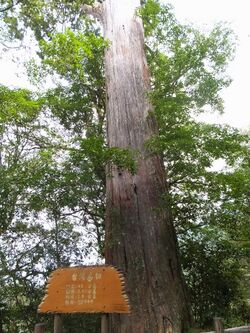Biology:Chamaecyparis taiwanensis
| Chamaecyparis taiwanensis | |
|---|---|

| |
| Scientific classification | |
| Kingdom: | Plantae |
| Clade: | Tracheophytes |
| Clade: | Gymnospermae |
| Division: | Pinophyta |
| Class: | Pinopsida |
| Order: | Cupressales |
| Family: | Cupressaceae |
| Genus: | Chamaecyparis |
| Species: | C. taiwanensis
|
| Binomial name | |
| Chamaecyparis taiwanensis Masam. & Suzuki
| |
| Synonyms | |
| |
Chamaecyparis taiwanensis (Taiwan cypress; simplified Chinese: 台湾扁柏; traditional Chinese: 臺灣扁柏; pinyin: tái wān biǎn bǎi) is a species of cypress, native to the mountains of Taiwan, where it grows at altitudes of 1300–2800 m.[1][2]
Description
It is a slow-growing coniferous tree growing to 40 m tall with a trunk up to 2 m in diameter. The bark is red-brown, vertically fissured and with a stringy texture. The foliage is arranged in flat sprays; adult leaves are scale-like, 0.8–1.5 mm long, with acute tips (unlike the blunt tips of the leaves of the closely related Japan ese Chamaecyparis obtusa (Hinoki Cypress), green above, green below with a white stomatal band at the base of each scale-leaf; they are arranged in opposite decussate pairs on the shoots. The juvenile leaves, found on young seedlings, are needle-like, 4–8 mm long. The cones are globose, smaller than those of C. obtusa, 7–9 mm diameter, with 6–10 scales arranged in opposite pairs, maturing in autumn about 7–8 months after pollination.[1]
Taxonomy
It is most commonly treated as a variety of Chamaecyparis obtusa in European and American texts,[1] but more often accepted as a distinct species by Taiwanese botanists.[3][4] The two taxa differ in ecological requirements, with C. obtusa growing primarily on drier ridgetop sites, while C. taiwanensis occurs on moist soils and with higher rainfall and air humidity.[1]
Related species
A related cypress also found on Taiwan, Chamaecyparis formosensis (Formosan Cypress), differs in leaves which are green below as well as above without a conspicuous white stomatal band, and longer, slenderer ovoid cones 6–10 mm long with 10–16 scales.[1][2]
References
- ↑ 1.0 1.1 1.2 1.3 1.4 Farjon, A. (2005). Monograph of Cupressaceae and Sciadopitys. Kew: Royal Botanic Gardens. ISBN 1-84246-068-4.
- ↑ 2.0 2.1 Rushforth, K. (1987). Conifers. Helm ISBN:0-7470-2801-X.
- ↑ Hwang, S.-Y., Lin, H.-W., Kuo, Y. S., & Lin, T. P. (2001). RAPD variation in relation to population differentiation of Chamaecyparis formosensis and Chamaecyparis taiwanensis. Bot. Bull. Acad. Sinica 42: 173-179
- ↑ Hwang, L.-H., Hwang, S.-Y., & Lin, T.-P. (2000). Low Chloroplast DNA Variation and Population Differentiation of Chamaecyparis formosensis and Chamaecyparis taiwanensis. Taiwan J. Forest Sci. Available online
Wikidata ☰ Q5069350 entry
 |


